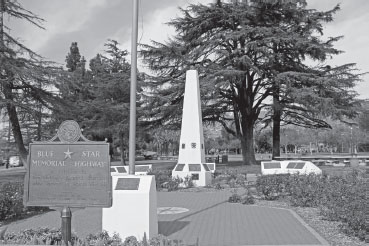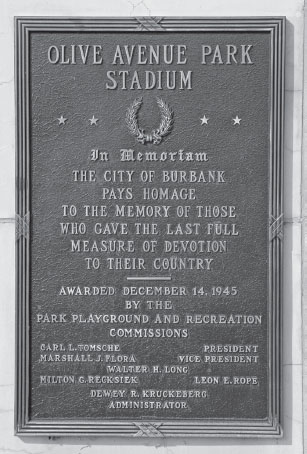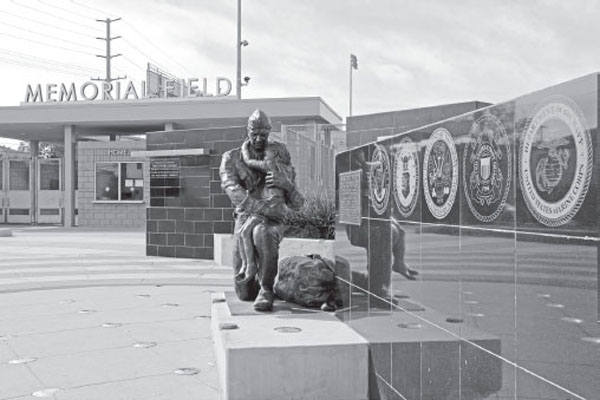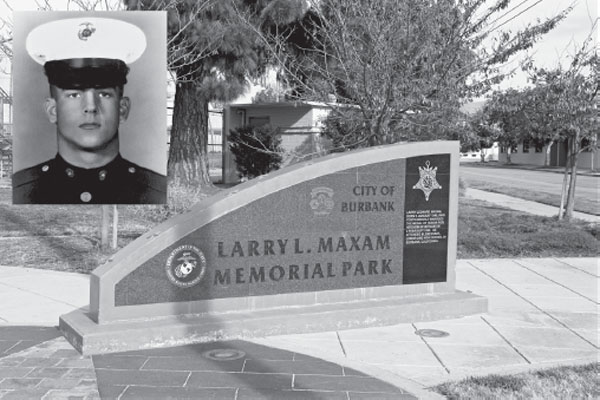
The Eternal Flame at McCambridge Park, with various commemorative plaques. A major remembrance ceremony takes place here each Veterans Day. Wes Clark .
10
THE ULTIMATE SACRIFICE:
BURBANK’S WARRIORS
As is the case in uncounted American communities, Burbank citizens have answered their country’s call to serve in times of conflict. Burbank was a small, six-year-old incorporated city when Americans joined the effort in World War I in April 1917, yet 177 patriotic Burbankers answered the call to serve. In World War II Burbank sent thousands of men and women into the service. During the Korean War and in Vietnam, Burbank again answered with thousands of service personnel. Today, Burbank is represented by service members in the Global War on Terror (GWOT).
In all these conflicts Burbank has lost too many of its sons and daughters, who made the ultimate sacrifice for freedom. All are remembered each Memorial Day with their names read aloud and a rose placed on the war memorial at McCambridge Park in their honor, so that they will not become part of Burbank’s lost memories. Each life lost has a story. Here we highlight a few of the many.

The Eternal Flame at McCambridge Park, with various commemorative plaques. A major remembrance ceremony takes place here each Veterans Day. Wes Clark .
(NOTE: Mike McDaniel has complied a substantial book of the stories, where available, of our lost Burbank veterans who served in all wars. It is a much more complete account than we can present in this chapter, and we encourage you to obtain a copy. See the bibliography.)
WORLD WAR I
In World War I, Burbank lost four sons that we can account for. They are as follows: Manuel Chafino, Harry L. Colton, Ray F. Enos and James McCloud, who was awarded the Distinguished Service Cross for his actions with the Twenty-sixth Infantry Regiment, First Division, on July 19, 1918.
Burbank medical doctor Frank W. Coulter was awarded the British Distinguished Conduct Medal in 1917 by King George V at Buckingham Palace for saving the lives of wounded British soldiers during combat in France.
WORLD WAR II
In World War II, Burbank lost 210 of its sons and 1 daughter in the conflict. 51 This was a rather large number for a part-rural, part-urban community of Burbank’s size. What’s more, Burbankers took part in the war before the United States did: Thomas Stark Hunter volunteered and flew for the 357th Squadron of the Royal Air Force. Albert O. Wedin was a sergeant in the Royal Canadian Air Force, serving as an aerial gunner.
The city’s first loss was at the Japanese bombing of Pearl Harbor on December 7, 1941: Walter Leon Collier was a young Marine aboard the USS Oklahoma . 52 He was killed that day. A young woman, Wallace Crowder, was a WAC (Women’s Army Corps) who died in a POW camp after her capture in the Pacific.
One World War II service member’s death took place in Burbank: on December 22, 1943, Army Air Force lieutenant colonel William Edwin “Ed” Dyess, a survivor of the infamous Bataan Death March and a subsequent Japanese POW camp, crashed his P-38 Lightning in a vacant lot of the corner of Myers Street and Olive Avenue near St. Finbar Catholic Church. (One eyewitness reported that the P-38’s left wing and left wheel struck the St. Finbar steeple.) Dyess was killed instantly. Shortly after his death, the Chicago Tribune received permission from the U.S. Army censorship office to print Dyess’s account of his experiences on the Bataan Death March. Starting in January 1944, the story ran in serial form for weeks and was distributed nationally by over one hundred American newspapers. When the story was published in book form in 1944 as The Dyess Story (later titled The Bataan Death March ), it became a bestseller. Dyess was buried in Texas.

The memorial plaque at the Olive Avenue Stadium. Wes Clark .

Memorial Field at John Burroughs High School. Wes Clark .
KOREAN WAR
In the Korean War, Burbank lost twenty of its sons. Three of these young men served together in the same unit: Bobby Box, David Ellis and Edwin Giron all fought in the First Cavalry, Fifth Regiment, when they were killed. Ellis, a combat medic, died attempting to save his fellow soldiers.
VIETNAM
In Vietnam, Burbank was again called on to send its citizens off to war, and fifty-six Burbankers lost their lives in service to their country. One man became Burbank’s only Medal of Honor recipient: Corporal Larry L. Maxam of the U.S. Marine Corps. Maxam served with the First Battalion, Fourth Marines, Third Marine Division. His Medal of Honor citation is illustrative of his courage and heroism:
Place and Date: Cam Lo District, Quang Tri province, Republic of Vietnam, 2 February 1968 .
For conspicuous gallantry and intrepidity at the risk of his life above and beyond the call of duty while serving as a fire team leader with Company D. The Cam Lo District Headquarters came under extremely heavy rocket, artillery, mortar, and recoilless rifle fire from a numerically superior enemy force, destroying a portion of the defensive perimeter. Cpl. Maxam, observing the enemy massing for an assault into the compound across the remaining defensive wire, instructed his assistant fire team leader to take charge of the fire team, and unhesitatingly proceeded to the weakened section of the perimeter. Completely exposed to the concentrated enemy fire, he sustained multiple fragmentation wounds from exploding grenades as he ran to an abandoned machine gun position. Reaching the emplacement, he grasped the machine gun and commenced to deliver effective fire on the advancing enemy. As the enemy directed maximum firepower against the determined Marine, Cpl. Maxam’s position received a direct hit from a rocket-propelled grenade, knocking him backwards and inflicting severe fragmentation wounds to his face and right eye. Although momentarily stunned and in intense pain, Cpl. Maxam courageously resumed his firing position and subsequently was struck again by small-arms fire. With resolute determination, he gallantly continued to deliver intense machine gun fire, causing the enemy to retreat through the defensive wire to positions of cover. In a desperate attempt to silence his weapon, the North Vietnamese threw hand grenades and directed recoilless rifle fire against him, inflicting two additional wounds. Too weak to reload his machinegun, Cpl. Maxam fell to a prone position and valiantly continued to deliver effective fire with his rifle. After one and a half hours, during which he was hit repeatedly by fragments from exploding grenades and concentrated small-arms fire, he succumbed to his wounds, having successfully defended nearly half of the perimeter single-handedly. Cpl. Maxam’s aggressive fighting spirit, inspiring valor and selfless devotion to duty reflected great credit upon himself and the Marine Corps and upheld the highest traditions of the U.S. Naval Service. He gallantly gave his life for his country .
Signed, Richard M. Nixon

Larry L. Maxam Memorial Park on West Pacific Avenue, in honor of Burbank’s only Medal of Honor recipient. Wes Clark/U.S. Dept. of Defense .
In 2010 the City of Burbank renamed Pacific Park Larry L. Maxam Park, in recognition of Burbank’s only Medal of Honor recipient.
GLOBAL WAR ON TERROR
As of this writing, Burbank has lost one of its sons in the Global War on Terror, David J. Hart, who died on January 8, 2008, during Operation Iraqi Freedom. From an article by the Associated Press :
Daniel Hart said he grew up emulating his brother, David—picking up the bass guitar because that’s what his brother played. He went on nighttime hikes with his brother and both slept under the stars in the freezing cold. “He was the toughest guy I knew, and he was always OK,” Daniel Hart said. “And knowing that, it made me OK.” Hart, 22, of Lake View Terrace, Calif., died Jan. 8 after he was wounded in a battle around Samarra. He was assigned to Fort Campbell. Hart grew up in Burbank and was home schooled, said his mother, Cherie Hart. Later, the family moved to the Lakeview Terrace campus of Youth with a Mission, a Christian ministry organization with an international reach. Hart went on missions to Romania, Tahiti, New Zealand and other countries. “David lived up to his name, which in Hebrew means: ‘well beloved,’ ‘dear,’” said his father, Jack Hart, during a memorial service. Spc. Richard Gilbert said his buddy would sacrifice to help others succeed. “If we were going on a run and someone fell back, he would fall back to help that soldier make the run.” He also is survived by his wife, Nicole .
Burbankers who lost their lives were awarded the following for their valor in service to their country: Medal of Honor (1), Navy Crosses (3), Distinguished Service Crosses (4), Distinguished Flying Crosses (8), Air Medals (meritorious achievement while in aerial flight) (35), Bronze Stars (acts of heroism in combat) (2), Silver Stars (gallantry in action against the enemy) (4), Prisoner of War Medals (7) and Purple Hearts (wounds received in combat) (229).
Burbank soldiers and airmen are also remembered on monuments in towns across Europe for their service. One town decorates their memorial near Mont-Dol in France, where the name of Burbanker Quentin L. Sandahl, a navigator, appears. Also, a Netherlands memorial is made from the propeller of a bomber that crashed near a town; Burbanker Warren F. Neilson was a gunner on this plane. Finally, Burbanker Myron Kendal Strickland is remembered on a memorial in Arlington National Cemetery.
The authors wish to memorialize the names of the Burbankers who never returned home, to remember their sacrifice.
To those who died
HONOR and ETERNAL REST;
To those still in bondage
REMEMBRANCE and HOPE;
To those who returned
GRATITUDE and PEACE .
(This inscription appears on the plaque dedicated on November 11, 1988, at McCambridge Park, 1515 North Glenoaks Boulevard in Burbank.)